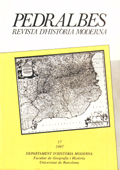Catalunya després del 1652: recompenses, censura i repressió
Abstract
With archival sources from the Arxiu de la Corona d'Aragó, Arxiu d’Història de la Ciutat de Barcelona and Biblioteca de Catalunya, this article approaches the Catalan political situation after don John of Austria took Bacelona (1652), bringing to an end the Catalan Revolt which started in 1640. First, the author identifies some features of the espionage service of don John's army during the siege of the city, particularly the services by Rafael Càrcel i Bals and his later moves in order to get appointments as a reward of his role as a spy. Secondly, the article highlights some aspects of royal repression upon Catalonia: collection of public documents belonging to the years spent under the French monarchy, control not only of the "insaculacions" (lottery for office) of "diputats" and "oidors", but also of other posts at the "Diputació del General"; new fiscal devices put into practice; control of the Diputació del General's behaviour and public display I of its emblems. Finally, it deals with the monarchy's call in 1655 against civil and military groups and individuals who kept their allegiance to the French monarchy after the takeover of Barcelona and, as an appendix, it gives the list of their names.
Downloads
Published
How to Cite
Issue
Section
License
Copyright (c) 1997 Eva Serra i Puig

This work is licensed under a Creative Commons Attribution-ShareAlike 4.0 International License.
Authors must agree with the following terms:
1. The author keeps authorship rights, ceding the journal the right to first publication.
2. Texts will be disseminated with a Creative Commons Attribution 4.0 International License. Which allows for the work to be shared with third parties, as long as they recognise the work’s authorship, the original publication in the journal and licensing conditions.
This requires acknowledging authorship appropriately, providing a link to the license, and indicating if any changes have been made. It can be indicated in any reasonable way, but not in a manner that suggests the licensor endorses or sponsors the use of the text.
If content is remixed, transformed, or new content is created from the journal's texts, it must be distributed under the same license as the original text



